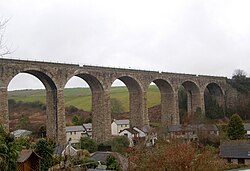Angarrack
| Angarrack | |
|---|---|
 Angarrack village under the railway viaduct | |
Location within Cornwall | |
| OS grid reference | SW584382 |
| Unitary authority | |
| Ceremonial county | |
| Region | |
| Country | England |
| Sovereign state | United Kingdom |
| Post town | HAYLE |
| Postcode district | TR27 |
| Dialling code | 01736 |
| Police | Devon and Cornwall |
| Fire | Cornwall |
| Ambulance | South Western |
| UK Parliament | |
Angarrack (
Geography
Angarrack is in a narrow valley from which the Angarrack River flows before entering the Copperhouse Pool in Hayle, through a specially constructed culvert designed to prevent flooding. However, in January 2003 the flooding was severe enough to be reported on the regional television programme
History
A mill known as Melynbran was recorded in 1342 and may be the mill, Conarditone, recorded in
There were also four mills on the Angarrack River. One was at Trungle; one (Angarrack Mill) was at the far end of the village on the junction of Grist Lane formally known as (the fields) and Steamer's Hill; one (Grist Mill) was situated at the northern end of the village; and one (Loggans Mill) still stands beside the Angarrack River at the eastern end of Hayle.
The main road between Redruth and the west once passed through Angarrack. Charles Wesley, following a visit to Redruth on 7 August 1743, was returning to St Ives via Angarrack and stopped to preach to a group of people who were at Velling-Varine (Mellenvrane). It is not known when a Methodist Society formed but the first mention is in 1779 when Angarrack was part of the Redruth Circuit.[8] The first chapel was built in 1843 and the present chapel was built in a quarry, near the smelting house and opened on 10 April 1874. A Sunday School was added in 1889 and Vestries in 1926.[9]
Hayle Railway
In 1834 the Hayle Railway built a 4-foot 8½ inch gauge track, over the 9.5 miles (15.3 km) from Hayle to Redruth. Above Angarrack originally horses, and from 1843 a stationary engine, hauled the trains up and down an incline.[10][11] The incline can still be seen on maps and the stationary engine is commemorated in the name Steamers Hill; the road leading to Connor Downs.[1] Following acquisition by the West Cornwall Railway a new line was constructed from Penzance to Trenowin Farm, to the east of Angarrack and the old line through Hayle and Angarrack was closed on 16 February 1852.[12] The new line bypassed the original Hayle Station and the incline by wooden viaducts built between 1850 and 1852. The present 11-span viaduct was built in 1888 for Great Western Railway beside the original viaduct.[13]
See also
- Gwinear
- Cornwall railway viaducts
References
- ^ ISBN 978 0 319 24304 6.
- ^ Historic England. "Monument No. 424710". Research records (formerly PastScape). Retrieved 13 January 2017.
- ISBN 0-904662-10-1.
- ^ "Angarrack". Cornwall Guide. 2 December 2015. Retrieved 13 January 2017.
- ^ Historic England. "Trungle Mill (424758)". Research records (formerly PastScape). Retrieved 13 January 2017.
- ^ Historic England. "Loggans Mill (1348409)". Research records (formerly PastScape). Retrieved 13 January 2017.
- ^ Historic England. "Angarrack Smelting House (424712)". Research records (formerly PastScape). Retrieved 13 January 2017.
- ^ Guiver, Dawn. "Wesleyanism in Angarrack". Angarrack Life. Retrieved 13 January 2017.
- ^ Guiver, Dawn. "Angarrack Chepel". Angarrack Life. Retrieved 13 January 2017.
- ISBN 978-0851530857.
- ^ Historic England. "Hayle Railway (424708)". Research records (formerly PastScape). Retrieved 13 January 2017.
- ISBN 978-1-904-34968-6.
- ^ Historic England. "The Viaduct At SW58353801 (1143709)". National Heritage List for England. Retrieved 13 January 2017.
External links
![]() Media related to Angarrack at Wikimedia Commons
Media related to Angarrack at Wikimedia Commons

